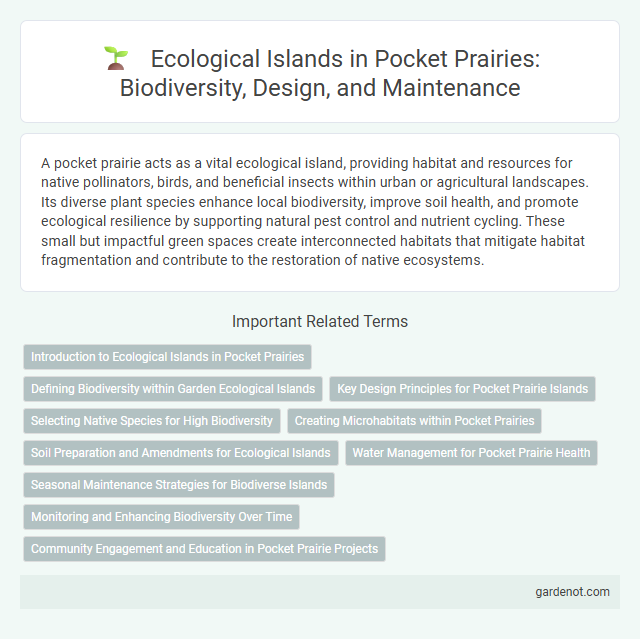A pocket prairie acts as a vital ecological island, providing habitat and resources for native pollinators, birds, and beneficial insects within urban or agricultural landscapes. Its diverse plant species enhance local biodiversity, improve soil health, and promote ecological resilience by supporting natural pest control and nutrient cycling. These small but impactful green spaces create interconnected habitats that mitigate habitat fragmentation and contribute to the restoration of native ecosystems.
Introduction to Ecological Islands in Pocket Prairies
Ecological islands within pocket prairies serve as concentrated habitats that support biodiversity by providing refuge for native flora and fauna amidst urban or agricultural landscapes. These islands enhance ecosystem services such as pollination, soil stabilization, and microclimate regulation, contributing to overall environmental resilience. By integrating native plant species and creating structural diversity, pocket prairie ecological islands promote sustainable urban green spaces and connective corridors for wildlife.
Defining Biodiversity within Garden Ecological Islands
Garden ecological islands serve as concentrated habitats that enhance local biodiversity by supporting a variety of native plant and animal species within small, managed spaces. These islands create microhabitats that foster ecological interactions, promote pollination, and increase resilience against environmental stressors. Defining biodiversity in this context involves measuring species richness, abundance, and ecosystem functionality to ensure the pocket prairie supports a balanced, thriving ecological community.
Key Design Principles for Pocket Prairie Islands
Pocket prairie islands are designed with biodiversity enhancement as a primary goal, incorporating native plant species that support pollinators and wildlife habitats. They emphasize soil health through minimal disturbance and organic matter integration to promote resilient ecosystems. Strategic spatial arrangement ensures connectivity within urban green networks, maximizing ecological function and aesthetic value.
Selecting Native Species for High Biodiversity
Selecting native species for pocket prairies ensures the creation of ecological islands that support high biodiversity by providing habitat for local pollinators, birds, and beneficial insects. Native plants like purple coneflower, little bluestem, and milkweed adapt well to local soil and climate conditions, promoting ecosystem resilience and reducing maintenance needs. Incorporating a diverse mix of grasses and wildflowers in various bloom periods enhances habitat complexity and sustains wildlife throughout the growing season.
Creating Microhabitats within Pocket Prairies
Creating microhabitats within pocket prairies enhances biodiversity by providing diverse niches for pollinators, insects, and small wildlife. Varied plant structures, soil types, and moisture levels support a range of species, fostering ecological resilience and natural pest control. Integrating native grasses, wildflowers, and woody plants optimizes habitat complexity, promoting healthy ecosystem functions in urban environments.
Soil Preparation and Amendments for Ecological Islands
Soil preparation for ecological islands in pocket prairies requires deep tilling and incorporation of organic matter to improve soil aeration and fertility, supporting native plant establishment. Amendments such as compost, biochar, and locally sourced mulch enhance microbial activity and nutrient retention while suppressing invasive species. Testing soil pH and nutrient levels guides precise amendment applications, ensuring optimal growing conditions for diverse prairie flora and fauna.
Water Management for Pocket Prairie Health
Water management in pocket prairies is crucial for maintaining soil moisture levels that support native plant growth and biodiversity. Techniques such as rainwater harvesting, permeable soil layering, and strategic planting of drought-resistant species optimize water retention and reduce runoff. Effective water management enhances ecological island functionality by sustaining habitat quality and promoting resilience to climate variability.
Seasonal Maintenance Strategies for Biodiverse Islands
Seasonal maintenance strategies for biodiverse ecological islands in pocket prairies emphasize selective mowing, invasive species control, and native plant nurturing during key growth periods. Early spring management targets removing invasive species before native flora emerges, while summer focuses on controlled burns or mowing to promote native grass and wildflower diversity. Fall and winter actions include debris removal and soil health monitoring to support nutrient cycling and prepare the island for the next growth cycle.
Monitoring and Enhancing Biodiversity Over Time
Ecological islands within pocket prairies serve as critical biodiversity hotspots, offering refuge for native flora and fauna amid urban landscapes. Continuous monitoring using species inventory and habitat quality assessments ensures adaptive management strategies that enhance ecosystem resilience. Implementing bioindicator species and remote sensing technologies effectively tracks ecological changes, promoting long-term biodiversity conservation.
Community Engagement and Education in Pocket Prairie Projects
Pocket prairie projects serve as ecological islands that enhance urban biodiversity and promote native habitat restoration. Community engagement initiatives, such as workshops and volunteer planting days, foster local stewardship and environmental awareness. Educational programs integrated into pocket prairies provide hands-on learning opportunities about native species, ecosystem functions, and sustainable land management.
Ecological island Infographic

 gardenot.com
gardenot.com